Saturday 28 February 2009
First terms film: Iterative Reconstructions
Iterative Reconstructions from Nancy Ni Bhriain on Vimeo.
Previous Film which dealt with using film to represent the reconstructive nature of memory:
It is known that the process of memory is a reconstructive rather than reproductive process, always including small elements of error or creation by the brain. This film explores the nature of memory; how every space one enters is experienced as a combination of previous experiences mixed with the sensory experience of the current physical space.
In the film the protangonist moves through a series of spaces of her own creation. We enter the process far into the iterative process. The initial scenes that are informing her choices of creation are long lost as recognisable wholes and now embedded as fragments within the new scenes. Within each scene, the character acknowledges fragments which go on to inform the next scene. The film culmulates in the merging of both visual fragments aswell as perspectives experienced previously by the protangonist.
Friday 27 February 2009
down the corridor
feathery moving structure
Using the hair module with the feather function and two different materials.
linking the stalk to the head of the flower using expresso, would be better if it had more of a bend
Particle test
First test with particles. Particles are going to be used to change parts of the structure into new forms, to represent the dynamism of the system.
Also, might be a way of merging scenes, to zoom into a miniscule scale and out to reveal the new structure.
This is basic particles in Cinema 4d, using 4 different omni lights with turbulence.
Global Illumination, Soft shadow mapping
It took 4 hour 22 minutes, the output is 700 x 400, probably should have made it smaller.
Playing around with the lights to create the heavenly feeling of the final scene - its a bit 0sx leopard for my liking at the moment.
Thursday 26 February 2009
Systems Architecture...
The structure of components, their interrelationships, and the principles and guidelines governing their design and evolution over time
It is a representation because it is used to convey the informational content of the elements comprising a system, the relationships among those elements, and the rules governing those relationships.
It is a process because a sequence of steps is prescribed to produce or change the architecture, and/or a design from that architecture, of a system within a set of constraints.
(All taken from Wikipedia: Systems Architecture)
List of texts to use to develop critique
The Projective Cast: Architecture and Its Three Geometries
Robin Evans
MIT Press, Cambridge, Massachusetts, London, England
1995
Vision and Visuality
Hal Foster
1988
Downcast Eyes: The Denigration of Vision in Twentieth Century French Thought
Martin Jay
University of California Press, Berkeley, Los Angeles, London
1994
The Production of Space
Henri Lefebvre
Translated by Donald Nicholson-Smith
Blackwell Publishing, Malden, USA, Oxford, UK, Victoria, Australia
First published 1974
Translated 1991
Architectural Representation and the Perspective Hinge
Alberto Pérez Gomez and Louise Pelletier
MIT Press, Cambridge, Massachusetts, London, England
2000
Exploring the nature of contemporary vision - in the context of media and techno /cyberspace
Simulations
Jean Baudrillard
Foreign Agent Series, distributed by The MIT Press
1983
The Virtual Window: From Alberti to Microsoft
Anne Friedberg
MIT Press, Cambridge, Massachusetts, London, England
2006
Exploring the scientific explanation of perception and consciousness
I am a strange loop
Douglas Hofstadter
Basic Books: A Member of the Perseus Books Group, New York
2007
Making Up the Mind: How the Brain Creates our Mental World
Chris Frith
Blackwell Publishing, Malden, USA, Oxford, UK, Victoria, Australia
2007
Eye and Brain
The Psychology of Seeing
R.L Gregory
Weidenfeld and Nicholson, London
Third Edition 1977
Thesis (Written and Design) Aims
The building and its life as a film is intended to explore this process, using the architecture as a definition of the structural systems, hierarchies and mechanisms at work.
But as I read and research more I realise that my real interest is in this representational process. The representational process of perception, the crossover between the theories of vision and the scientific evidence constantly emerging that shows the brain translates information and organises it in systems to produce our sense of perception.
The ongoing process of learning dictates how we perceive our surroundings. In the context of neuroscience, this is explained through plasticity, with visual theory, in terms of cultural context. I'm interested in this link.
Robin Evans in his book The Projective Cast, discusses architecture and its representation through the notion of projection. The line which I found most suitable for my research was
"Composition, which is where the geometry of architecture is usually sought, may still for convenience be considered the crux of the matter, but it has no significance in and of itself. It obtains all of its value via the several types of projective, quasi-projective, or pseudo projective space that surround it, for it is only through these that it can be made available to perception." (xxxi)
My thesis hopes to work in the transitional zone between this statement and the scientific theory of perception. Can how we consume space be understood both as both?. To understand the system at play in the consumption of space, I will look at both cultural contexts and their manifestations as visual constructs aswell as probing at realising through the design of my building and its projections in my film an intuitive depiction of the neurological processes at work in perception.
The baroque aesthetic is not incidental, as I spoke of earlier when discussing Martin Jay's essay Scopic Regimes of Modernity, the baroque vision (I will try to prove 0r at least discuss) is most appropriate in representing our current media-rich landscape. I want to prove that the notion of the baroque, one of fractured, multiplicitous vision is indeed analogous to the modern / postmodern age experience of vision. That evershifting viewpoints and a return to an individual ego-centred world is best expressed through the principles of the baroque.
The use of anatomical existing building elements of the brain, tissue, neurons, arteries etc, to create this baroque architecture is based on the initial metaphor of the brain as the ultimate systems architecture for producing perception. It is within the architecture of this organ that all modes and constructs of vision and their subsequent representations comes from.
So, in a sense, the written thesis aims to question space perception through the means of it representation in a cultural context and to conclude / suggest how this defines our perception of space within our current time. The physical / practical design thesis works alongside this research to test and represent the theories in an analogous architecture. This architecture aims to represent our reliance on our learned cultural context in the consumption of space as well describing the system it implies in a visually understandable way.
Proposed work for end of project:
1. Large plan showing the route of the protagonist through the infinite Borges like library, the only parts drawn in detail are her route. This is to represent that the brain's architecture is formed by its use, through our experiences which demand certain processes using specific areas in it. This plan is in a sense only one of many that could be drawn during different stages of the protagonist life, but the one I will produce is obviously of her current position in time, one which although produced as a combination of previous experiences / memories is not meant to be read as combination of all from all times.
 Piranesi's fragment drawing of ancient Rome
Piranesi's fragment drawing of ancient Rome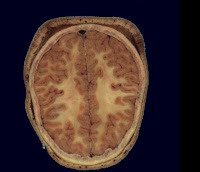
2. Series of smaller plans roughly A2 size which show slices through the brain building at different levels. The infinite nature of the building means that it can be read sectionally as wel
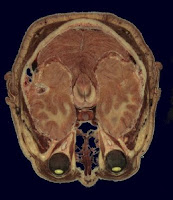 l as in plan to an endless level. These drawings will address, the systems I have identified in how we process visual information into perception (neurologically and culturally)
l as in plan to an endless level. These drawings will address, the systems I have identified in how we process visual information into perception (neurologically and culturally)
3. A section showing these relationships
4. A film which deals with the relationship between the systems of perception and the output of experience. In it as discussed previously, the protagonist moves through two distinct spaces - one the library which represents her processes of perception and secondly the 'real' space where she both receives the inputs and experiences the outputs. For the sake of simplicity and clarity, her experiences will be limited in this space, it will all take part in one room.
5. A series of details of the areas of the building
A booklet documenting the production of all of the above
Wednesday 25 February 2009
Sunday 22 February 2009
Lacanian interpretation of Perspective
"Both Jacque Lacan and Martin Jay posited theoretical disadvantages to the construction of single point perspective paintings. These two theorists lead a drive to embrace anamorphosistic, baroque and modern art as the more productive and enhancing experiences for the viewing subject. According to Lacan, what the subject desires most is to be recognized as a distinct individual, unlike any other. The subject wants others to see her as she sees herself. This fundamental lack of true or real subjectivity drives the subject to work ceaselessly to shore up her constantly dissipating sense of selfhood. The subject ardently wants to establish her identity as a fixed thing, something constitutive of her being, but she simultaneously intuits that her subjectivity is not fixed. So she makes or acquires pictures, purchases objects and property, espouses or rejects values and ideals all in the name of "who she is"; all the while, the subject never consciously realizes how fragile, unstable and derivative her subjectivity truly is.
Lacan's notion of why we look at pictures starts with the gaze. The gaze is desire. Rather, the gaze is the tool of the desiring subject, what she sends out into the world to secure a sense of self or at least shore up her deficit of subjectivity. Lacan says that a subject's recognition of herself is dependent upon "misrecognition" or "meconnaissance" because the subject assumes its own concreteness and uniqueness. Prior to Lacan, the gaze was characterized as something a subject does to the objects in the world around her. Lacan, however, changes the terms entirely and speaks of visuality, which is something quite different from subjects gazing upon objects; Lacan's view of visuality and the gaze is much more complex--he speaks of gazing as a chiasmic function. He uses a diagram of two triangles superimposed upon one another to illustrate how the picture and the subject are both held within the matrix of the gaze and the subject of representation. Put more simply, when a subject masters a picture by gazing upon it, she is at the same time formulated by the picture. In other words, to achieve the goal of being recognized, the subject must become an object, seen and recognized by the very things she makes objects of.
Lacan believes that the subject gazing upon a single-point perspective painting, such as Raphael's Marriage of the Virgin (mentioned earlier in this essay), starts to see herself as the center of the universe. She regards the world and its objects from a choice vantage point; everything in her line of vision conforms to Brunelleschi's mathematics of sight. Mathematically-plotted pictures enable a way of seeing that seems at first to support the subject's notions of distinct and masterful selfhood. This rationalist perspective satisfies the subject's urge to see herself as fixed and complete until she contemplates the vanishing point. When, in her perusal of the picture, she encounters the vanishing point, she becomes troubled by the reciprocal relationship between subject and object. If her object recognizes her, as she indeed wishes it to, then it becomes unclear to her, symbolically speaking, whether she still occupies the vantage point or has become the vanishing point.
"From Lacan's point of view, rationalist or scientifically informed painting, despite the fact that it is apparently easy to see and digest, menaces the subject, forcing her into an endless series of psychological maneuvers to avoid confronting the nothingness that the picture's vanishing point shows her she is. Rationalist paintings provide the viewer with only two alternatives of being: master of the universe (at the vantage point) or cipher (at the vanishing point.) Each alternative fails to accurately encapsulate who the subject is. Lacan seems to propose that innovations to single-point perspectivalism, may offer the viewing subject an escape from the master/cipher straight jacket. Lacan says that paintings are a trap for the gaze, and once trapped, the gaze is temporarily calmed and pacified. This tamed gaze or "dompte regard" gives the viewer rest from the athletics of the master/cipher dichotomy. Caravagio presented innovative art to his patrons in the church five hundred years ago when he created paintings that broke with single point perspective in favor of picture planes containing foreshortened space and subtly engineered multiple perspectives. Gazing upon a Caravaggio, the subject is no longer forced into the inherently false role of master of the universe, nor does identification with the vanishing point annihilate her. Instead, she may adopt any or many of the positions that the picture plane offers. In this respect, art that departs from Renaissance notions of single point perspective constitute a constructive difficulty for the viewer, one that allows the viewer to see herself more honestly, as a split and multiple subject."
Saturday 21 February 2009
Vision and its link to the Philosophy and Beliefs of its Time
What I personally find most interesting about this essay is that in each instance, the context of the historical timeframe that each theory arises from seems inextricably linked to it. This throws up an interesting question - does the nature of vision change depending on when we live and experience culture? Also, if our vision is changed - thus the space we perceive too is altered, laying out the final question, what is our contemporary space? Can I use the critical techniques of the essay or ones like it to decifer a notion of vision for 2009 and what is the space it perceives?
This question brings me back to my interest in the ideas explored and developed by neuroscience. Because of the brain's plasticity, the individual's experience shapes their perception of space and reality. The individuals experience is among others shaped by the era they are part of.
But back to Jay.
 The Baptism of Christ by Leonardo da Vinci (1472 - 1475)
The Baptism of Christ by Leonardo da Vinci (1472 - 1475)1. Cartesian perspectivalism:
Otherwise known as one point perspective which came from southern European Renaissance ideas, it exemplified the Renaissance endeavor to incorporate science into all aspects of life. Although the word Cartesian stems from its association to René Descartes, Jay sees Cartesian perspectivalism as being contrary to Descartes philosophy . Jay quotes Richard Rorty from his 'Philosophy and the Mirror of Nature" (1979) "In the Cartesian model the intellect inspects entities modeled on retinal images...In Descartes' conception - the one that became the basis for 'modern' epistemology - it is representations which are in the mind."
Jay finds fault in a number of areas with this method of vision, which assumes a fixed and singular eye / viewing point. Jay argues that that both viewer and painter are disembodied, writing that "the bodies of the painter and the viewer were forgotten in the name of an allegedly disincarnated, absolute eye." It is unnatural, not accounting for normal binocular vision or the dynamic, saccadic motion of the human eye. He writes
"In Norman Bryson's terms, it followed the logic of the Gaze rather than the Glance, thus producing a visual take that was eternalised, reduced to one"point of view" and disembodied."(p.7)
He also notes that this de-eroticises the art: "The moment of erotic projection in vision - what St Augustine had anxiously condemned as "occular desire" - was lost as the bodies of the painter and viewer were forgotten in the name of an allegedly disincarnated, absolute eye." (p.8)

The Music Lesson by Johannes Vermeer (1632-75)
2. Baconian perspectivalism
As a sub group of Cartesian perspectivalism occuring in Northern Europe, in exemplified by the Dutch 17th century painters like Vermeer, in which the eye of the observer ceases , the frame is removed and the work is based around the objects existing independently of a viewer.
"The projection is, one might say, viewed from nowhere. Nor is it to be looked through. It assumes a flat working surface." (p.15)
The emphasis is on the fragmentary nature of reality, "attention to many small things versus a few large ones; light reflected off objects versus objects modelled by light and shadow; the surface of objects; their colours and textures, dealt with rather than their placement in a legible space..." (p.13 - quoting Svetlana Alpers. The Art of Describing: Dutch Art in the Seventeenth century p.44) Modern day photography and film are described as being the descendants of these method of vision.
 The Hermitage Winter Palace, St Petersburg by Rastrelli
The Hermitage Winter Palace, St Petersburg by Rastrelli3. Baroque Vision:
Jay is most interested and excited by this model of vision which he desribes as "more radical alternative". Although introduces 'the baroque' by its conventionally understood context in the 17th century and its links to the Catholic counter Reformation, he goes on to state that "it may also be possible to see it as a permanent, if often repressed, visual possibility throughout the entire modern era."
Using the writing of the French philosopher Christine Buci-Glucksmann, La Raison Baroque of 1984 and La folie du voir of 1986, he sets up this third model as the one most relevant and appropriate to the reality of vision in the modern age. There are many comparisions to be made in the way in which he describes this vision with the writings of the deconstructivists such as Derrida. He writes, "the baroque self-consciously revels in the contradictions between surface and depth, disparaging as a result any attempt to reduce the multiplicity of visual spaces into any one coherant essence."
He himself compares it to other philosophical systems: "Leibniz's pluralism of monadic viewpoints, Pascal's meditations on paradox, and the Counter Reformation mystic's submission to vertiginous experiences of rapture might all be seen as related to baroque vision."
Thursday 19 February 2009
Rorschach Ink blots

I realised while looking at my sketch plan of my library that it bore a striking resemblance to the Rorschach ink blot drawings that are used in psychoanalysis. Perhaps if I am using the Lacanian / Freudian interpretation of buildings as metaphors for the human personality and am allocating levels of the building to represent different levels of consciousness, levels of ego or levels of reality and fantasy, the ink blot shapes could define the various strata through the building, each ambiguous shape made as one which bears a resemblance in some way to its true function.
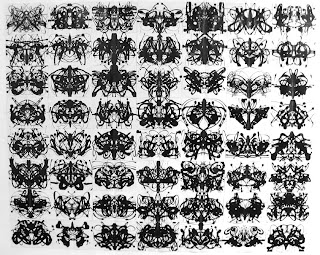
Tuesday 17 February 2009
Lacanian analysis of film
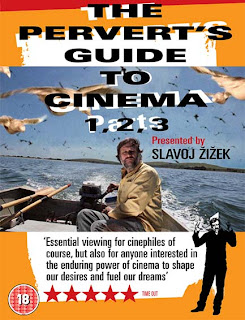
I recently watched Slavoj Zizek's 'The Pervert's Guide to Cinema' which is a witty and interesting account and interpretation of a number of seminal films (lots of Hitchcock and Lynch as well as many earlier classics like The Red Shoes and The Possessed) using Lacanian / Freudian analysis. Although tenuous at times, it offers explanations for broken and multiplied storyline structures (Lynch) as well as the symbolic nature of elements (e.g the flocks of birds as representational of the heroine's desire and sexuality in Hitchcock's The Birds) and even explains the representation of the 3 elements of a personality as the levels of the house in Hitchcock's Psycho: Basement - the base Id, harbourer of our deepest and irrational fears and desires, obscene and out of control, where Norman Bates houses his dead mother, the Ground Floor, the ego - the rational and normal, on this level of the house Norman still clings to some semblance of normal behaivour and then the first floor - the super ego, the maternal ego - striving for control and perfection. It is from this level that we see and hear Norman talking to his endlessly nagging mother, always trying to please her but never succeeding.
The use of the house as metaphor for the structuring of the personality elements is of interest to my project. Is there a translation that I can use to make it work in the context of brain architecture within neuroscience? I wonder...
Monday 16 February 2009
Initial sketches


The corridor is dimly lit only by the growing arteries and the pulse and flash of their tendrils as they sprout books from their stalks. The walls and desks and chairs are all comprised of fleshy muscular like structures which branch out to form the shelving housing a vast array of colourful books. At a pulse the pattern formed by the books alters. When the protagonist interferes with the process a tendril dies leaving at first a gap in the shelf but then a new and strange pattern.
In the final scene the protagonist finds herself in a massive cathedral like hall. Everything is comprised of book patterns which are the flowers of the anatomical fleshy tendrils. They burst into life completing altering the landscape in a kaleidescopic burst of colour and light and electricity. Light bursts forth from the two massive stained glass windows .

Architecture as Metaphor
Architecture can be viewed as a representational tool, one which allows a flow of understanding between seemingly disparate areas of knowledge. Through its incarnation in walls, windows, doors, columns and the promenade through their various possible arrangements, complex and subtle theories can be represented and thus understood clearly. Arguably, this visual and spatial representation of ideas can further their meaning and create new avenues of exploration within them.
The design of a 'Library of the Brain' which I am currently undertaking seeks to represent the workings of the brain as that of a constantly dynamic organism, one which grows and shrinks according to use and one which processes information and produces maps of said information. It also seeks to represent the relationship between these internal workings and the external / personal physical experience of these mental maps.
On a slightly skewed note, other reading I have been doing of Lacan and Zizek - Freudian influenced philosophers has opened the possibility of the assessment of my project as a representational journey of the self through reality and its incarnations: The Imaginary, the Symbolic and the Real.
The question I find interesting here is whether new developments in neuroscience - the ability to now more than ever witness how the brain processes and reveals reality can shed light on what it is to exist, to have consciousness and the Freudian theories expounded to explain such things?
Psychoanalysis, I have always found to be lacking in scientific rigour and experimental evidence proves that its direct use doesn't have particularly positive effects. However, the questions it forced into public debate into human consciousness and sub consciouness has been fruitful in the understanding of the human mind as a complex system. Only recently since technology has allowed for methods of brain scanning has neuroscience - the study of the brain (and thus the mind) become a real science - that is one which can be empircally measured and tested. Freud's analysis although insightful and ground breaking was speculative and subjective, not as he claimed scientific.
In my current project, I hope to use architecture as a representational tool to question and understand an individuals experience of reality in relation to both current understandings of neuroscience aswell as Lacanian / Freudian notions of the self.
Sunday 15 February 2009
Updated library plan segment

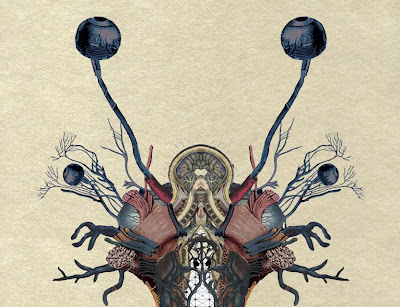
This chamber extends outwards like the optic nerve does from the brain to the exterior with which the brain negotiates information.
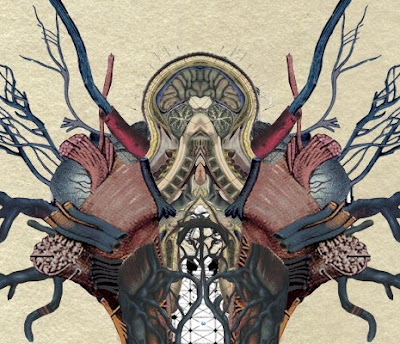


Saturday 14 February 2009
Alice in Wonderland Syndrome

There was a very interesting paper written discussing Alice In Wonderland in the context of Neurological research. It explained many of the strange occurences in the novel by giving them explanations in brain change. For example the scene where Alice witnesses / experiences her neck lengthening is now a known neurological syndrome named Alice In Wonderland Syndome caused by overstimulation of the area in the brain that deals with the body image of the head and neck area.
One of my ideas has been to let my protagonist (a loose version of Alice) to experience this sensation after her alter self has tampered with the interior of the library.

Borges: The Library of Babel
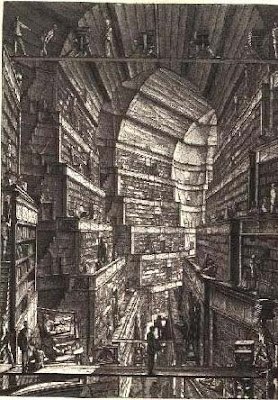
One of the inspirations is Borges short story 'The Library of Babel' which is one of a collection of short stories in the book 'Labyrinths'. Brain like, it is infinite and unknowable - constantly studied and yet ultimately elusive in its ultimate workings.
Friday 13 February 2009
Initial Chronogram: Film, narrative and plans

The brain's plasticity means that at
 any time our behaviour and experiences are shaping our experience of reality. We experience our environment through a complex set of actions and translations and processes in our brain. We form a giant mental map which is comprised of both our innate predispostions towards what is most likely, (things like shadows are formed underneath objects due to the postion of the sun above the earth) and learned rules of probability. At every moment of our lives our brain is measuring the information our senses is giving it against its internal mental map. It is constantly updating itself and correcting and shifting itself according to our experience.
any time our behaviour and experiences are shaping our experience of reality. We experience our environment through a complex set of actions and translations and processes in our brain. We form a giant mental map which is comprised of both our innate predispostions towards what is most likely, (things like shadows are formed underneath objects due to the postion of the sun above the earth) and learned rules of probability. At every moment of our lives our brain is measuring the information our senses is giving it against its internal mental map. It is constantly updating itself and correcting and shifting itself according to our experience.What is most interesting is that we in fact have no direct relationship with the reality we assume we live in. We communicate with the outside world and experience it solely through the organ of the brain which does so by a continual series of processes, computing and sorting sensory inputs into a legible and tangible output.
Most of the time, this experience is seamless and we are blissfully unaware of this overwhelmingly delicate and complex process, how
 ever like all systems there can be glitches, times when simple processes become interrupted or overly charged and suddenly, our usual reality is sparked into fantastical realms.
ever like all systems there can be glitches, times when simple processes become interrupted or overly charged and suddenly, our usual reality is sparked into fantastical realms.It could be claimed that we can start to understand our experience of reality - space, enviroment, tim
 e by looking at these glitches as they provide the best place to note the processes that are occuring.
e by looking at these glitches as they provide the best place to note the processes that are occuring.I am working on a project which hopes to address the nature of our relationship to reality through the grand machine that is our brain.
I am representing the process as a giant, infinite library, one where information is taken in, stored, sorted and distributed. One which has areas of private storage, archived journals, secret old historical volumes and lighter, daily borrowed books. This building is only formed by the route that a user takes through it, like the brain, the routes and paths that are used become stronger and from them new neural channels are formed in turn.
The building like an ancient city that has been discovered will have parts that have faded away and others which are still rich and detailed in experience, these factors depend entirely on the protagonist who inhabits the building alone.
The project will be realised as a building through drawings but also as a film, which will explore the temporal nature of its experience. In it the protagonist moves through chambers of the library, interacting with it and simultaneously finding an alterego self in a separate contrasting space. Gradually as the film unfolds, we the viewer will realise that the library and the protagonists interaction with it is producing the experience of her doppelganger in the 'other' space.
The film hopes to explore the relationships between production, control, communication and experience.

The library takes in an input, processes it and produces a controlled output which in turn creates the reality of the other space. The project hopes to explore how far these relationships can be pulled and distorted before reality itself stops existing in a known form.
















